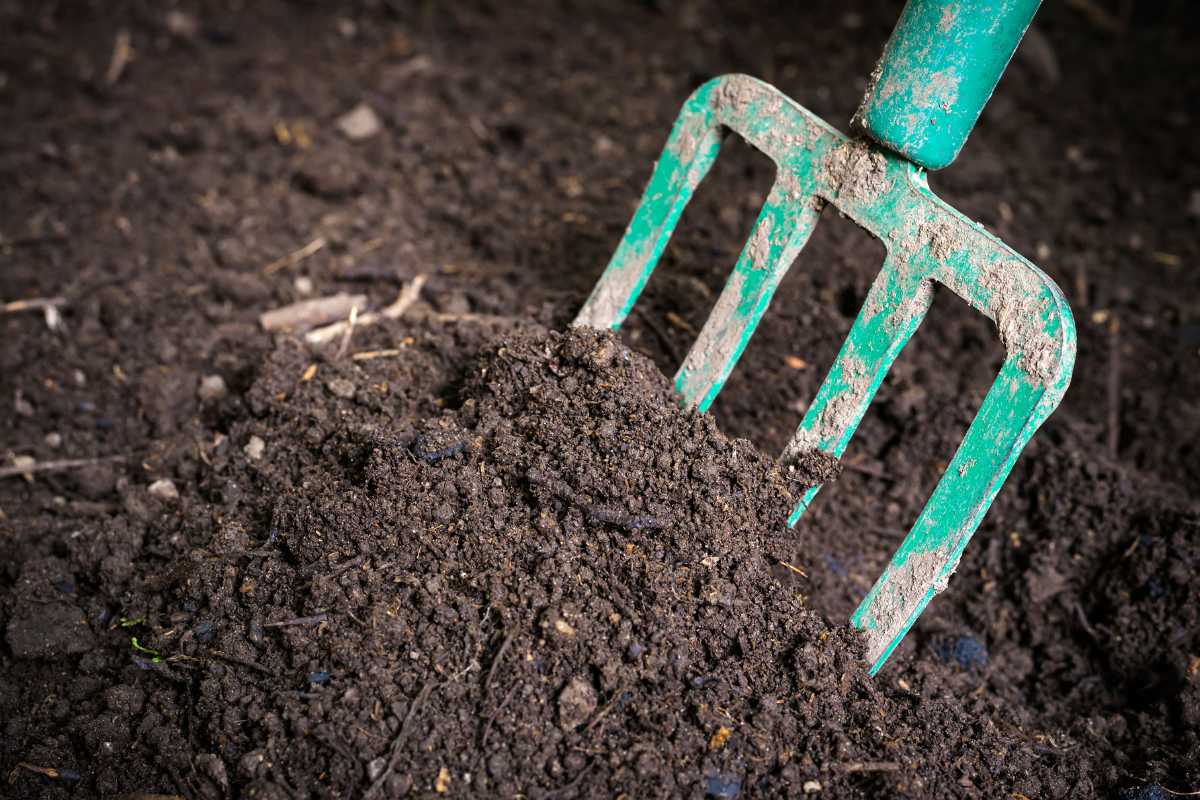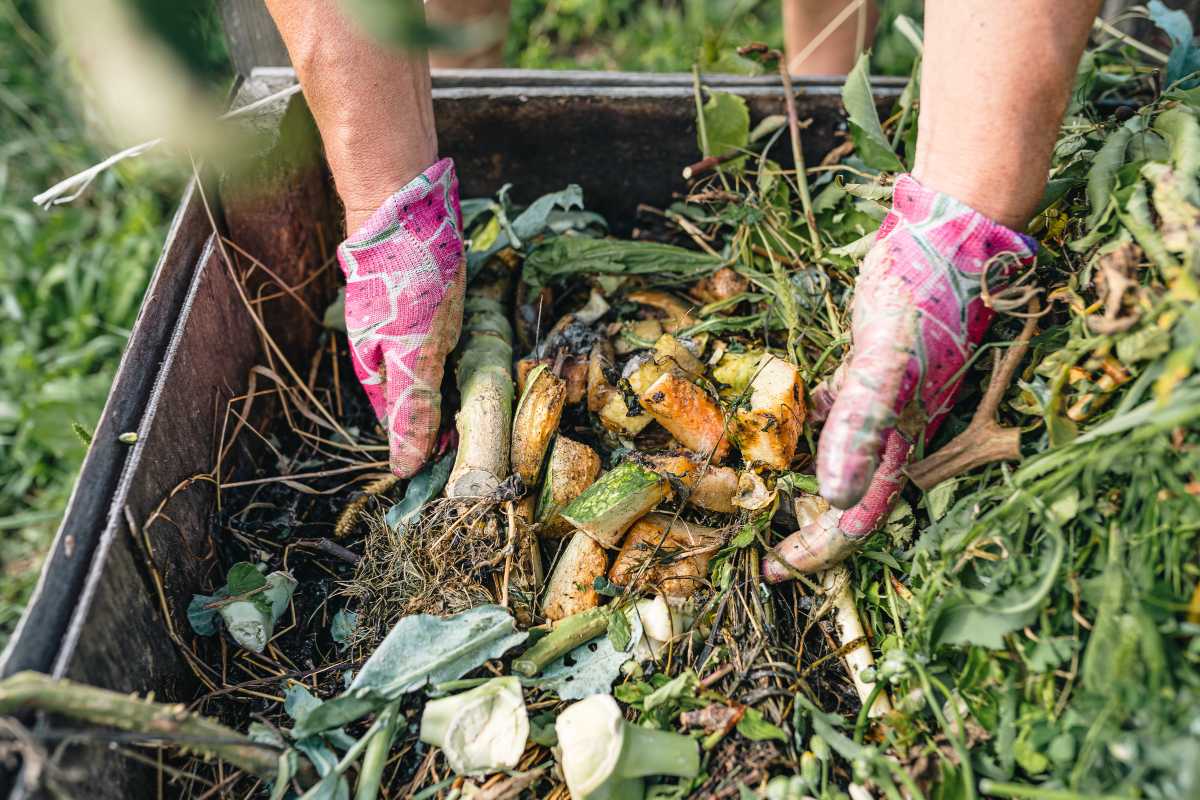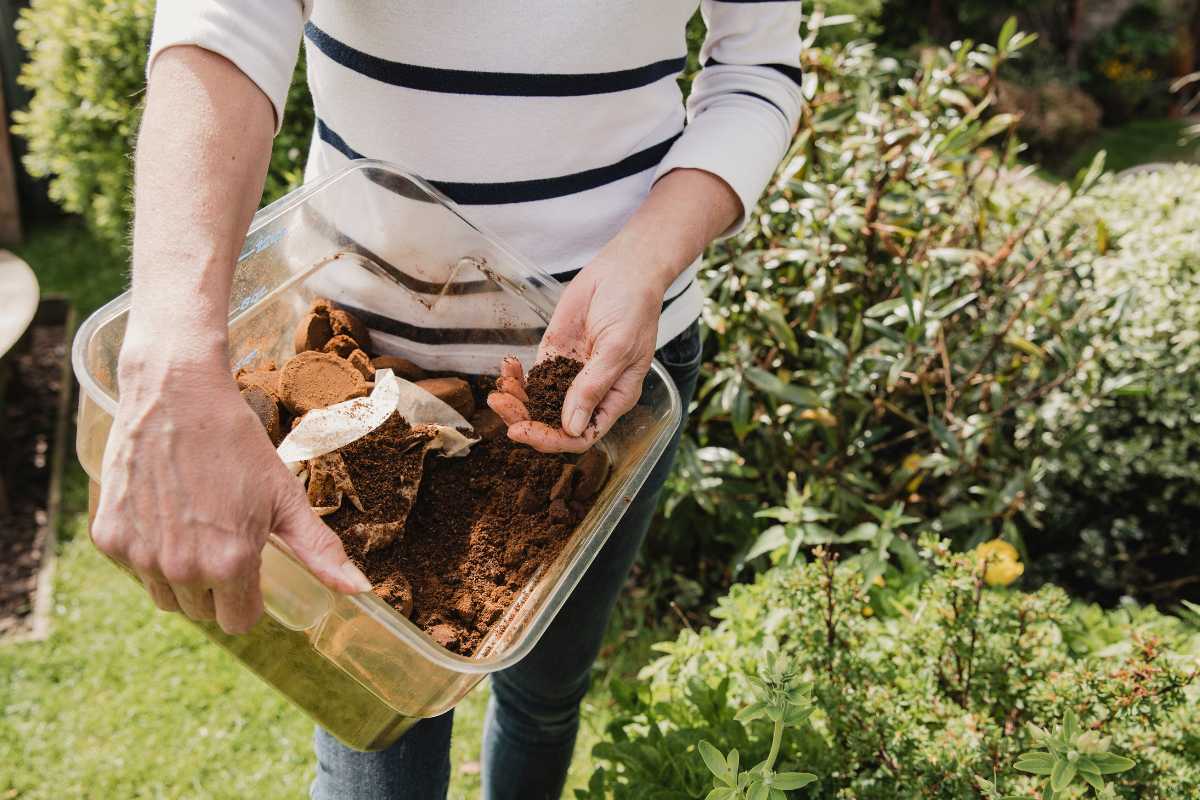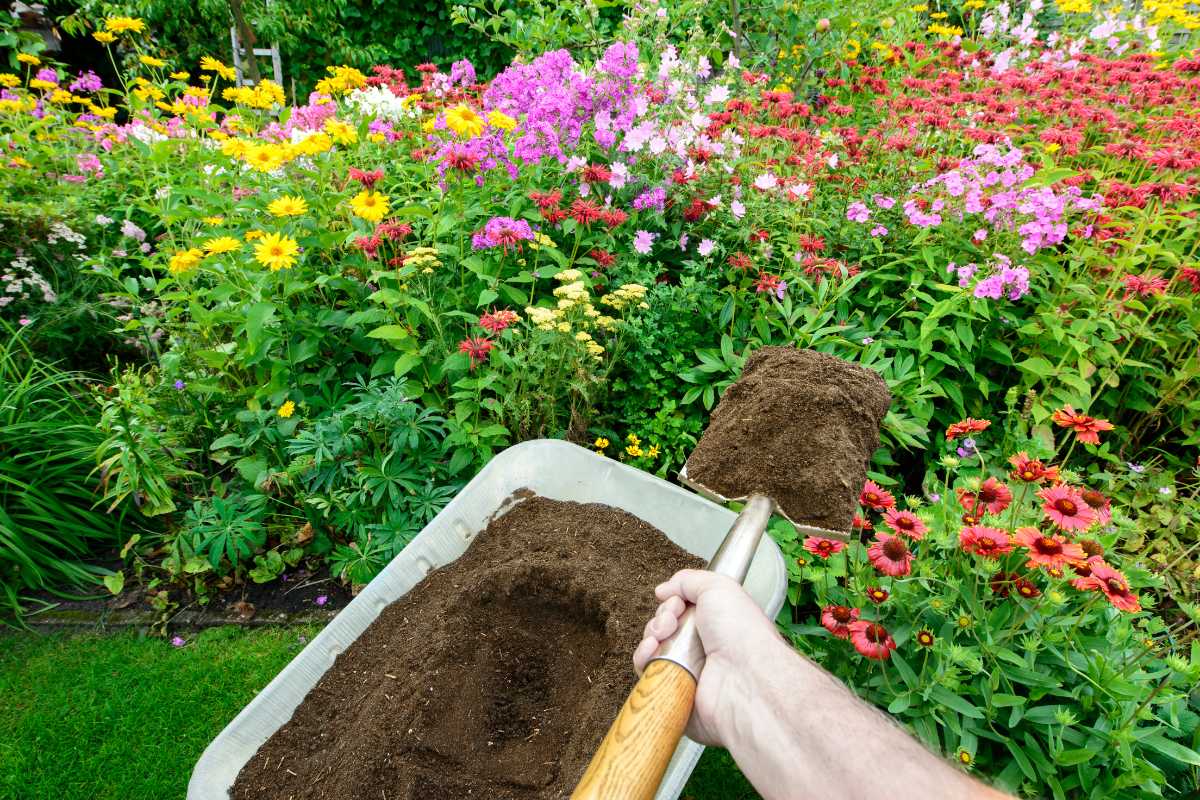Confused about whether to use topsoil or compost in your garden? You’re not alone. Both have their merits, but knowing when to use which can make all the difference in your gardening success.
Topsoil and compost are two rather different materials. They have very similar uses, but they also differ in a number of ways that can affect how you use them.
This article will help you understand the differences between topsoil and compost, so you know what to expect when using these soil amendments.
What is Topsoil?

Topsoil is the uppermost layer of soil, teeming with nutrients. It’s also known as a soil conditioner used for the top layer of soil for gardens and lawns.
It’s the go-to option for improving plant health and optimizing water management in lawns and gardens.
This top layer is also the most nutrient-rich part of the soil and when watered, the nutrients are provided to the plants.
Learn more about topsoil in this in-depth article: What is Topsoil?
What is Compost?

Compost is decayed organic matter, a cocktail of organic matter such as food scraps, plant material, grass clippings, leaves, and other yard waste and yard waste. It’s a nutrient powerhouse for plants and a boon for waste reduction.
Compost is organic matter that has been decomposed by microorganisms such as bacteria, fungi, and protozoa. This decomposition process produces humus, which is rich in nutrients that plants need for growth.
The composting process breaks down organic materials into smaller particles that are easier for plants to absorb. It also helps to reduce the amount of waste going to landfills.
- Read more about compost and humus in more depth: What is Compost?
- Compost vs Humus
When and How to Use Topsoil
Use topsoil when planting new flowers or veggies. It’s the secret sauce for lush lawns, thriving gardens, and eye-catching landscapes.
Topsoil is a mixture of organic matter, sand, and soil particles that has been mixed with water. It is usually applied to the top of the ground as a mulch to help retain moisture and nutrients.
If you use topsoil, then you don’t need to worry about watering the plant for weeks sometimes, depending on your plants. That’s because it retains moisture well.
To use topsoil, first remove any weeds. Then spread the topsoil over your lawn or garden area with an even distribution.
You may want to add some fertilizer before spreading the topsoil if you plan on fertilizing your lawn after planting seeds.
You should not apply too much topsoil at once because this could cause runoff problems. If you do decide to apply extra topsoil, wait until the rainstorms pass before applying additional topsoil.
When and How to Use Compost?

Using compost is great for growing vegetables, flowers, and herbs. But tread lightly if you’re planning to use it as lawn fertilizer; too much can upset nutrient balances.
If you add too much compost to your soil, it could cause nutrient imbalances in your plants.
Composting has many benefits and is a great way to reduce waste, and also helps in reducing pollution.
Composting is best when done outdoors because it requires a lot of space. Also, composting is a long process, and takes about 6 months for decomposition.
If you don’t already have compost available, you can make your own backyard compost pile with a good mixture of brown and green organic materials.
To use compost, simply add it to your garden soil. Make sure to mix it well with the existing soil. Adding compost to your soil increases its fertility level and makes it more nutritious.
When adding compost to your garden, be careful not to overwater your plants. Overwatering causes root rot and reduces crop yields.
To dig the compost into the soil, first remove any weeds growing around the roots of your plants. Then loosen up the soil around each plant’s base.
Finally, gently push the compost into the hole where you planted the seedlings.
Read the in-depth guide to Getting Started With Compost.
Cost Comparison: Topsoil vs. Compost
What’s the difference between topsoil and compost costs? You might think soil is just soil, but when it comes to topsoil and compost, the financial factors can be as diverse as the gardens they nourish.
Let’s dissect the cost variables for each, compare average prices, and offer takeaways to help you get the most bang for your buck.
Topsoil Cost Factors
- Quality: High-quality topsoil, rich in nutrients, often comes at a premium.
- Volume: Buying in bulk usually brings down the cost per cubic yard.
- Delivery: If you can’t transport it yourself, delivery fees can add to the expense.
- Regional Prices: Costs can vary based on location and local supply and demand.
Average Price: Depending on these factors, topsoil generally ranges from $12 to $55 per cubic yard.
Compost Cost Factors
- Type: Specialized composts, like those for roses or vegetables, may be more expensive.
- Organic vs. Non-Organic: Certified organic compost often costs more than its non-organic counterpart.
- Volume: Like topsoil, purchasing compost in bulk can offer cost savings.
- Store vs. DIY: Commercial compost is more convenient but often pricier than homemade options.
Average Price: Compost typically costs between $25 and $50 per cubic yard, depending on the factors mentioned.
Price Comparison Takeaways
- Initial Investment: Topsoil may offer a less expensive starting point, but consider its long-term nutritional value.
- Long-Term Value: Compost can be more cost-effective in the long run due to its nutrient density.
- DIY Savings: If you have the time and space, making your own compost can be the most budget-friendly option.
- Bulk is Better: For both topsoil and compost, buying in bulk is usually more cost-effective for large projects.
Compost vs Topsoil Pros and Cons
Compost Advantages
- Nutrient-Dense: Compost provides a wide array of nutrients and enriches soil fertility.
- Waste Reduction: It’s a great way to recycle organic waste, reducing landfill contributions.
- Soil Structure: Compost improves soil texture, making it easier for roots to grow.
- Eco-Friendly: It’s a sustainable option that helps reduce greenhouse gas emissions.
Compost Disadvantages
- Time-Consuming: Making your own compost can take up to six months.
- Space Requirement: Composting demands a significant amount of space.
- Odor: The decomposition process can sometimes produce unpleasant smells.
- Nutrient Imbalance: Overusing compost can lead to excessive nutrients, which may harm plants.
Topsoil Advantages
- Nutrient-Rich: Topsoil is packed with essential nutrients that plants need to grow.
- Water Management: It excels in retaining moisture, reducing the need for frequent watering.
- Versatility: Ideal for lawns, gardens, and landscapes, topsoil is a multi-use powerhouse.
- Ease of Use: Just spread it over the area, and you’re good to go—no special preparation needed.
Topsoil Disadvantages
- Cost: Quality topsoil can be expensive, especially for large projects.
- Potential for Weeds: Since it’s not sterilized, topsoil might introduce weeds to your garden.
- Inconsistency: The nutrient content can vary, so you may still need additional fertilizers.
- Runoff Risk: Applying too much can lead to water runoff, carrying away valuable nutrients.
Environmental Impact: The Eco-Friendly Choice?

Are you also considering the planet as you ponder between topsoil and compost? Both have their environmental pros and cons, which might tip the scales for eco-conscious gardeners.
Let’s delve into how each option impacts Mother Earth.
Topsoil Environmental Impact
- Resource Intensive: Extracting topsoil often involves significant land disruption, which can affect local ecosystems.
- Transportation: Large-scale topsoil projects may require transportation over long distances, contributing to carbon emissions.
- Chemical Concerns: Some commercial topsoils may contain synthetic fertilizers or pesticides, which have their own environmental drawbacks.
Compost Environmental Impact
- Waste Reduction: Composting recycles organic waste, reducing landfill contributions.
- Lower Emissions: Composting organic matter at home can lower greenhouse gas emissions compared to landfill decomposition.
- Sustainable Agriculture: Use of compost can improve soil structure, reducing the need for chemical fertilizers and promoting sustainable farming practices.
Eco Takeaways
- Local Sourcing: To minimize the environmental impact of topsoil, consider sourcing it locally.
- DIY Composting: Making your own compost not only reduces waste but also lowers your carbon footprint.
Can I Mix Topsoil and Compost Together?

Yes, you sure can! Mixing topsoil and compost together is a nutrient boost that creates an even better environment for your plants.
Using topsoil alone doesn’t provide enough nutrients for your plants. On the other hand, compost helps make up for the missing or lower amounts of nutrients needed for good health.
Mixing topsoil and compost allows you to get the benefits of both products without having to buy separate supplies.
Common Mistakes: Pitfalls to Avoid
Ever felt the frustration of a garden project gone awry? Sometimes, the devil is in the details. Whether you’re a seasoned green thumb or a gardening newbie, knowing common mistakes with topsoil and compost can save you time, money, and a whole lot of hassle.
Let’s explore these pitfalls and how to sidestep them.
Topsoil Mistakes
- Overapplication: Applying too much topsoil can lead to water runoff and nutrient imbalances.
- Neglecting pH Levels: Not testing the pH level of the topsoil can result in poor plant growth.
- Poor Quality: Opting for low-quality topsoil may introduce weeds or pests to your garden.
Compost Mistakes
- Overuse: Too much compost can lead to nutrient imbalances in your soil.
- Wrong Types: Using compost that’s not suited for your specific plants can hinder growth.
- Inadequate Mixing: Failing to properly mix compost with existing soil can result in uneven nutrient distribution.
Prevent Mistakes From Occurring
- Test First: Always test soil conditions before applying any amendments.
- Follow Guidelines: Adhere to manufacturer or expert guidelines for application rates.
- Quality Matters: Whether it’s topsoil or compost, quality is key. Always opt for the best you can afford.
Topsoil vs Compost Final Thoughts
Whether it’s topsoil for a verdant lawn or compost for a veggie bonanza, the right choice hinges on your gardening goals.
For example, if you’re looking to grow grass instead of veggies, then you’ll probably prefer using topsoil.
On the other hand, if you’d like to grow lots of veggies, then you might find yourself preferring compost.
Here are other related articles to learn more about topsoil and compost:
- Topsoil vs Garden Soil Differences
- Calculating How Much Compost is Needed
- Can You Still Use Unfinished Compost?
Compost vs Topsoil FAQs
Which is better topsoil or compost?
Compost is much easier to create than topsoil. Topsoil requires a lot of work and money. To create topsoil, you need to go to the store and buy soil and mix it together. If you don’t know what kind of soil to use, you should use topsoil. However, compost is easy to make. All you need to do is find some wood chips, grass clippings, leaves, straw, and kitchen scraps, and put them into a pile. Then cover the pile with other materials, such as newspaper, cardboard, plastic bags, etc. The pile will turn into compost in about six months.
Can I use compost instead of topsoil?
You can use compost instead of topsoil, but not for all uses. Compost is a mixture of organic matter such as leaves, grass clippings, food scraps, and manure. Compost helps soil retain water and nutrients, and improves plant growth. Topsoil is a mixture of sand, clay, silt, and organic matter. It is used for planting seeds and growing plants.
Is topsoil or compost better for the garden?
Topsoil and compost are both great for the garden. Choosing one or the other depends on their usage. Topsoil is organic matter such as decomposed plant debris, soil, sand, pebbles, and other fine materials that are mixed together to form a rich, fertile mixture used primarily for planting. Compost is made from dead plants, leaves, grass clippings, and other organic waste that are placed in compost piles where bacteria break down the waste into humus. The finished product is then added back to the ground as fertilizer.
Is compost better than dirt?
Compost is much better than dirt because it is organic matter that has been broken down into nutrients for plants. Dirt is just soil, which is mostly made up of minerals and rocks. However, compost requires some work and time to produce quality soil for your garden. If you don’t have the time or patience, then just use dirt.
Does compost turn into soil?
Yes, compost turns into soil, but only after 6 to 12 months of decomposition. Once you start adding organic matter to the soil, you will notice that the soil becomes darker and richer. If you want to speed up the process, the compost should be turned regularly. The compost should be turned at least once a week.
Can I use topsoil for potted plants?
Yes, you can use topsoil for potted plants. Topsoil is a mixture of soil and sand that allows water to drain through easily. But topsoil doesn’t contain enough nutrients. If you put your plant in topsoil, you should add some fertilizer and keep the soil moist.
Sources:
- https://calrecycle.ca.gov/organics/processors/
- https://www.cityofventura.ca.gov/2524/Free-Compost-Mulch-Program
- https://apps.ecology.wa.gov/publications/documents/0907032.pdf
- https://kingcounty.gov/en/legacy/depts/dnrp/solid-waste/compost-calculator.aspx
- https://blogs.ifas.ufl.edu/pascoco/2017/12/04/potting-soil-topsoil-compost-seed-starting-potting-mix-whats-difference/
- https://www.canr.msu.edu/news/the_shocking_truth_about_topsoil

